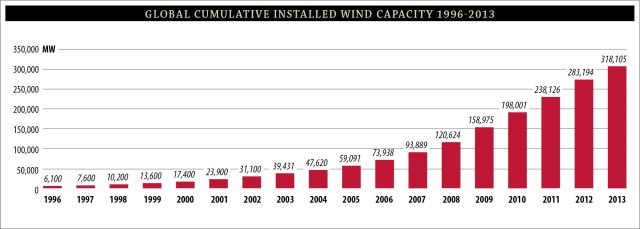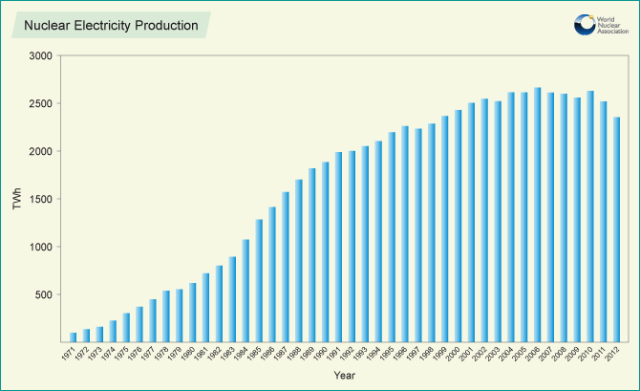
It’s not like this will come as startling news to most readers–most of us already have a strong sense that renewables are far better than either nuclear power or carbon capture/storage (CCS) at addressing our climate crisis.
After all, that’s the main message the Nuclear-Free, Carbon-Free Contingent is taking to the People’s Climate March in New York City September 21.
But it’s nice to see others take the same position, especially when bolstered with facts. That’s what Mike Barnard did yesterday in CleanTechnica.com with his article Wind Energy Beats Nuclear & Carbon Capture For Global Warming Mitigation.
Barnard begins with the simple reality that the James Hansen’s of the world just can’t seem to grasp:
“There’s an enduring myth related to wind energy and nuclear energy that needs to be put to bed. That myth is that only nuclear can be scaled to sufficient capacity to reduce the impacts of global warming, and that wind energy is much less scalable so it should be ignored.”
The article focuses on China because:
“China is the true test bed for maximum scalability of nuclear vs wind. It has a tremendous gap between demand and generation. It can mostly ignore lack of social license for nuclear. It is building both wind and nuclear as rapidly as possible. It has been on a crash course for both for about the same period of time. It has bypassed most of the regulatory red tape for nuclear which sensibly exists elsewhere given concerns about economic fallout of Fukushima-scale disasters, nuclear proliferation and terrorism. And in four years it has built significantly less nuclear generation capacity than it built of wind generation capacity in 2013 alone.”
That’s where reality comes in. In 2013 alone, China installed more than 16 GW of new wind capacity, while in the four years 2010-2014 it managed to put only 4.7 GW of new nuclear into operation. Even accounting for nuclear’s higher capacity factor than wind (and Barnard uses a generous 90.9% capacity factor for nuclear), Barnard finds:
“Running the math, that’s about 6.5 GW of real capacity of wind energy in one year vs 4.3 GW of real capacity for nuclear over four years. That’s roughly six times more real wind energy capacity than nuclear per year.”
Barnard isn’t anti-nuclear, by the way. He thinks nuclear is actually a good choice for power generation where it makes economic sense. The problem is–that’s nowhere. He also thinks CCS is worthwhile, but will play only a limited role in the future, while we don’t think it’s even worth the bother.

He points out that nuclear power generation worldwide is dropping. It reached its high point in 2006 and we’ll argue it likely will never reach that point again.
2006, by the way, was also the high point in electricity generation generally for the U.S. Then along came the Great Recession, which caused a drop in electricity demand that–because of the success of state-level energy efficiency programs and rooftop solar (which usually isn’t counted as generation, but rather is counted as a drop in demand), may never recover in the U.S. even with continued economic growth.
While Barnard focuses on wind, the same argument holds true for solar power, although so far to a lesser extent in terms of global deployment. But solar is now growing just as rapidly, if not more so, than wind, and thus the key argument–that renewables can and will scale up much more rapidly than nuclear could–holds true for solar as well.
As Barnard concludes:
“Nuclear isn’t more scalable than wind or other renewables, in fact it’s going in reverse while renewables are being expanded rapidly. And CCS won’t dodge more climate change than renewables because wind and solar are being built in production rapidly and CCS isn’t and won’t be in comparable scales because the economics don’t support it. Both are busted myths.”
Michael Mariotte
July 30, 2014
Permalink: https://www.nirs.org/2014/07/30/yep-wind-is-better-than-nukesccs-for-climate/
You can now support GreenWorld with your tax-deductible contribution on our new donation page here. We gratefully appreciate every donation of any size–your support is what makes our work possible.
Comments are welcome on all GreenWorld posts! Say your piece above. Start a discussion. Don’t be shy; this blog is for you.
If you like GreenWorld, you can help us reach more people. Just use the icons below to “like” our posts and to share them on the various social networking sites you use. And if you don’t like GreenWorld, please let us know that too. Send an e-mail with your comments/complaints/compliments to nirs@nirs.org. Thank you!
GreenWorld is now posted on tumblr at https://www.tumblr.com/blog/nirsnet
Note: If you’d like to receive GreenWorld via e-mail daily, send your name and e-mail address to nirs@nirs.org and we’ll send you an invitation. Note that the invitation will come from a GreenWorld@wordpress.com address and not a nirs.org address, so watch for it.




We can power the Earth without fossil fuel or nuclear power. With a combination of solar, wind, hydroelectric, hydrogen fuel cell, geothermal, tidal, river current, biomass, conservation, mass transit and appropriate technological re-engineering of industrial, commercial processes, heating, cooling and lighting, we can get off fossil fuel and nuclear power. Visit The Solutions Project at http://thesolutionsproject.org/ for more ideas for all 50 states of the US. Fossil fuel, like nuclear power are both too dangerous, too expensive and totally unnecessary for our energy needs, Read the State Impact Series from American Public Media at http://stateimpact.npr.org/pennsylvania or read the “Drilling Down” series from the New York Times, at http://www.nytimes.com/interactive/us/DRILLING_DOWN_SERIES.html . According to Dr. Mark Jacobson of Stanford University and Dr. Mark Delucchi of the University of California at Davis, the only thing that we are lacking is not the scientific and technical know how or natural resources or manufacturing capability to do this, but the political will. And contrary to the propaganda of the dirty fuel industries and electrical power companies, transitioning to a renewable energy economy by 2050 will not “wreck our economy” nor leave us “starving and freezing in the dark.” Just look at Germany, which is well on it’s way to getting off of all fossil fuel by 2050 and shutting down all of their nuclear power plants by 2022. If the Germans can do this, we can do it.
Reblogged this on your passport to complaining and commented:
This clever article uses the crash courses in China for both nuclear and wind expansion to put to bed the myth that only nuclear can scale to address climate change. Useful reading.
Well, this article, at least, fails to argue that wind is better than nuclear for the climate. Possibly it is, that’s not my point. All this article tells us is that, over the last few years, China has installed more wind generation than nuclear. You might as well say that 100 people traded in their Hummers for new cars and that 70% bought a Ford and 30% bought a Honda and that, therefore, Fords are better for the environment. That may or may not be true. It only tells us about choice, not about the mileage they achieve. In this case, China has a very high level of availability for both Wind and Nuclear. Both sources will continue to be built. The article looks at a small recent window to note that China has installed more wind in the last few years than nuclear, but fails to note the massive construction campaign noted over the coming decade to install more nuclear. It also fails to note that China continues to use massive amounts of coal and will continue to install more coal capacity, and it will continue to supply some 75% of their supply.
Regarding Capacity Factors, you suggest that the 90.9% factor is “generous” but that is the capacity factor for all American plants in 2013. Further, you seem to have applied a 40% capacity factor for wind, which would, in my opinion, be “generous”. I believe 25-30% would be more typical. Further, even if 40%, that is 40% that is generated whenever it is generated, which may or may not be when it’s required.
A real watt by watt comparison is required in order to evaluate which is better, and there is unlikely to be a single solution that will make sense in all circumstances.
The point of the article was that even considering wind’s lower capacity factor than nuclear, China is installing wind faster than it is installing nuclear. China was chosen as the example since it is the country installing the most capacity of all kinds; in the U.S., for example, wind and solar are going up at a much higher rate since nuclear construction is barely happening. As for coal in China, yes, it is still too high although today it was announced that coal is going to be banned entirely in the Beijing region by 2020 and this is likely to be a harbinger for the future there. China does have a continued nuclear construction campaign, but as we have reported on GreenWorld in the past, it is dwarfed by their renewable construction campaigns. Finally, while the 90.9% capacity factor is indeed the factor for mature U.S. reactors, it is unreasonable to use such a factor for new reactors in China, especially since many are of new and unproved reactor designs. It typically takes several years for reactors to work out the bugs and reach high capacity factors; China is likely to prove no exception. We didn’t apply a 40% capacity factor for wind, the article did, but that is a fair capacity factor for current generation wind turbines now being built; clearly older turbines are in the 25-30% range you describe.